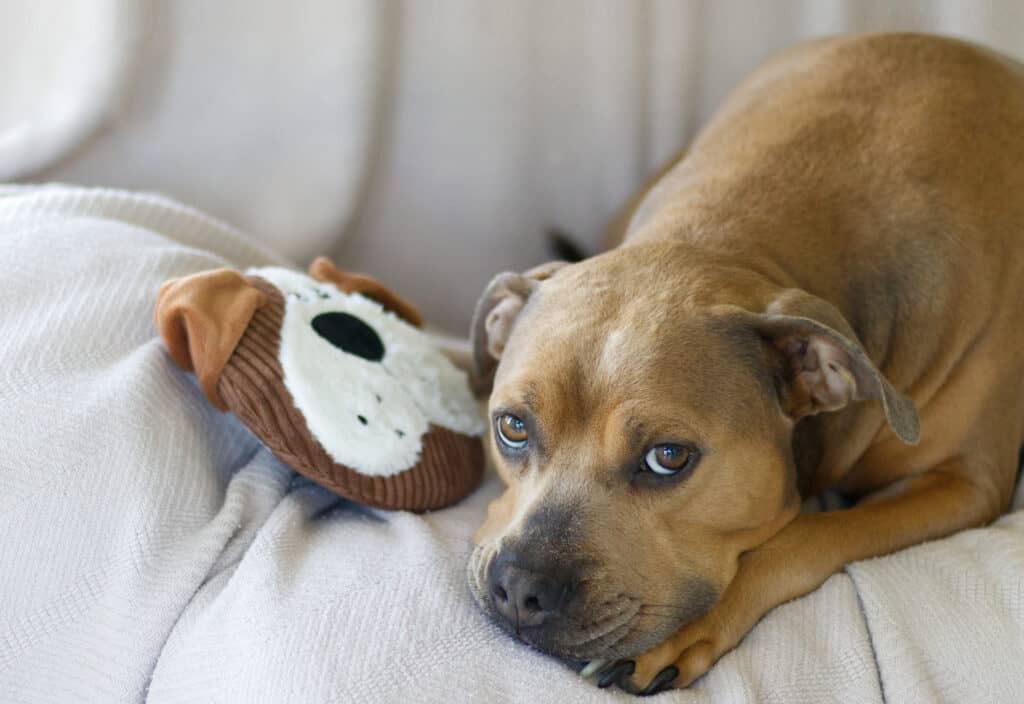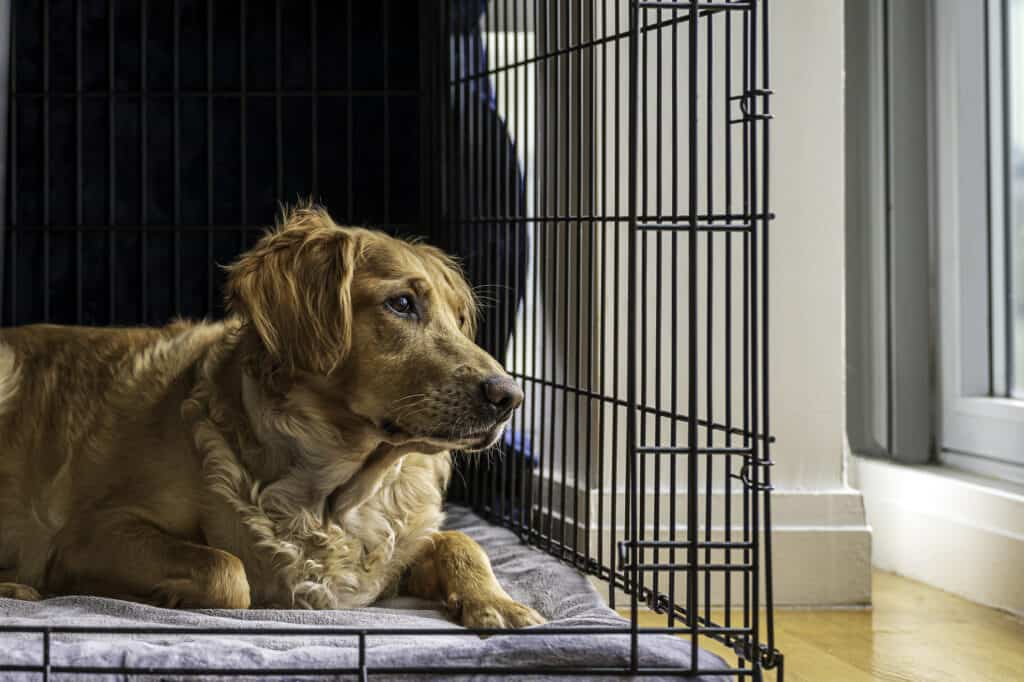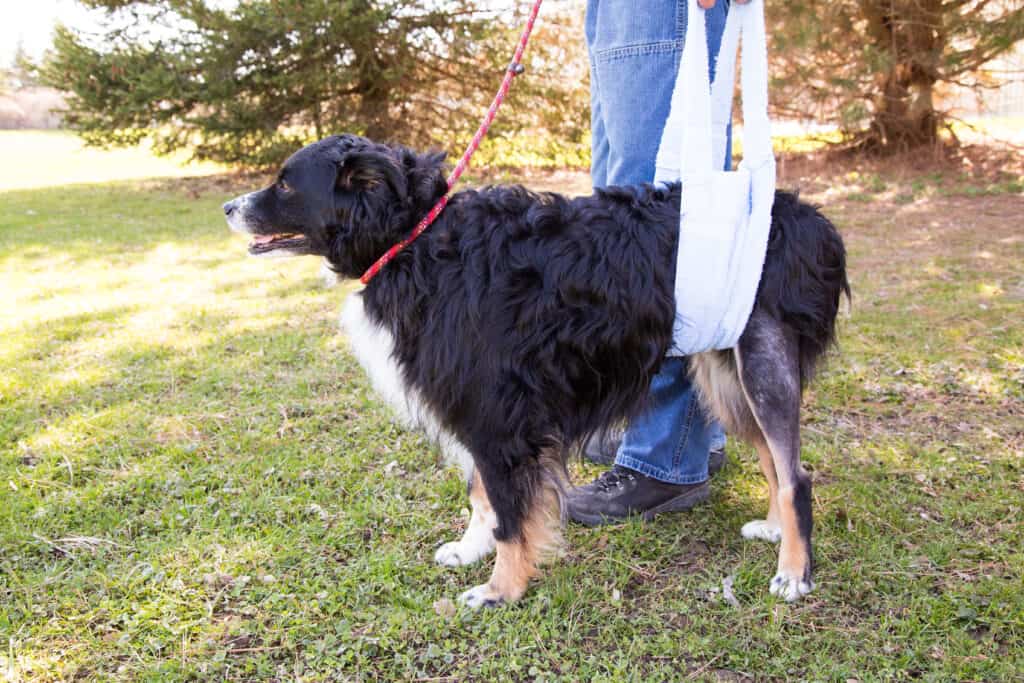A torn ACL is a painful injury that can impact both humans and canine friends. An ACL injury can change a dog’s life in an instant, as it comes with significant discomfort and often requires a lengthy treatment plan.
Due to how significant the trauma of an ACL tear is in dogs, it’s important to be as educated on the topic as possible. Any canine companion can fall victim to a torn ACL, which is why we want you to have all the details needed to offer your dog the help they need in this situation.
In this article we will help you better understand the details surrounding a torn ACL in dogs, and introduce you to the most common treatments that can help your dog with an ACL injury recover. Let’s get started!
What is a Torn ACL in Dogs?
Just like you and I, our dogs have a variety of muscles, tendons, and ligaments that help to support the canine knee. These structures around the knee can easily become injured during a variety of activities, especially the canine version of the ACL. Dogs do not actually have an ACL like humans do, but they have a ligament known as the cranial cruciate ligament (CCL) that performs a similar role as the human ACL. Due to how similar the ligaments are, many vets will refer to the canine CCL as the ACL to help pet parents understand the impact of the injury.
If a dog’s CCL becomes strained any way, this can have a devastating impact on the furry friend in question. The cranial cruciate ligament provides some of the most critical support for the canine knee, so any injury to this ligament can make it impossible to move around normally. Not only is a CCL strain or tear incredibly painful, but many dogs will be unable to put any weight on the limb when their CCL has been injured. CCL injuries in dogs can vary from minor strains to complete tears, but any sign of a possible knee injury in your dog should be taken seriously.
While a torn CCL in dogs can occur due to a variety of reasons, there are a few common scenarios that vets see when dogs come into the clinic for sudden limping. Some of the most common ways that dogs tear their cranial cruciate ligament includes:
- Sudden twisting of their knee, often when a dog is running and changes their direction suddenly
- Accidently stepping in or tripping over a hole while they are running
- Jumping off high surfaces that put intense pressure on the knee when landing
- Improper breeding that has led to joint disease or impaired growth
- Ligament deterioration due to obesity, joint disease, or even years of intense exercise
As we mentioned above, CCL injuries in dogs can range from minor strains to complete tears of the ligament. This means that the symptoms listed above can vary in severity, but due to risk of the injury worsening, we always suggest taking your pup to the vet from the moment you notice any pain in their limbs. Having the injury assessed and treated from the moment you notice it will also help your dog find relief much sooner, as your vet will be able to implement a treatment plan immediately.

Dogs can tear their cranial cruciate ligament (CCL) by jumping from height which puts intense pressure on their knees when landing.
©iStock.com/wooyaa
What are the Symptoms of a Torn ACL in Dogs?
The only way that you can offer your dog adequate support when they injure their CCL is by being aware of the most common symptoms of a knee injury. Once you have an idea of what you should always keep an eye out for in your canine friend, you can make sure that your pup receives adequate treatment from the moment their CCL tear develops.
Some of the most common signs and symptoms of a torn cranial cruciate ligament (CCL) in dogs includes:
- Hearing your dog suddenly cry out during physical activity
- Noticing sudden limping in your dog, and this can range from a minor limp to not being able to put any weight on the limb
- Appearing guarded of the limb and not allowing anyone to touch it
- Toe touching on the effected limb, which means only being able to put a small amount of weight on the leg
- Changes in their sitting position, often sitting with their injured leg straight out
- Reluctance to participate in their favorite physical activities
- Swelling around the knee which often occurs soon after the initial injury
- Hearing a clicking sound coming from their knee when they move, or even when you move their leg
- Thickening of their knee joint over time, especially if treatment is not sought immediately after the injury
Pain from a CCL injury in dogs can vary based on how severe their tear is, so this means their symptoms will range in severity as well. No matter how minor your dog’s limp is, if their symptoms last for more than 24 hours, we always suggest having them assessed by your veterinarian. If they cannot put any weight on their leg and they appear to be in significant pain, we suggest giving your vet a call from the moment you notice their symptoms.

Reluctance to participate in their favorite physical activities, signs of swelling around the knee or limping may be a sign of a CCL injury.
©Cheryl Ann Studio/Shutterstock.com
What Should I Do If I Think My Dog Tore Their ACL?
If you think your dog might have torn their ACL, you are likely searching for answers on what to do next. The best way to set your pup up for success is by reaching out to your vet from the moment you notice any abnormal symptoms, and they can offer you the best guidance on how to move forward. Your vet will likely recommend that you come into their office and have your dog seen, and based on their physical exam, they can determine what might have happened to your pup.
While you wait for your appointment with your veterinarian, we do suggest implementing strict exercise restriction and keeping your dog crate rested until they are seen. This means that unless your dog is going outside to go potty or they are sleeping, they should be in a confined space and avoiding any exercise. This will help to prevent any further injury in the meantime.
Most vets will perform a pain exam on the limb, perform a few range of motion exercises, and they might even recommend a set of x-rays on the limb to rule out any bone fractures. If your vet is able to rule out any other potential causes of sudden pain or lameness in the affected leg, then they can determine the best plan of action based on the severity of your dog’s injury. They will also factor in any budget constraints that you might have, as this is an important factor that needs to be considered before moving forward.
Treatment for a torn CCL in dogs can require everything from long term dog knee braces to a skilled surgery to repair the ligament, so your veterinarian will need to talk you through each treatment option in detail. To make sure you are prepared for any treatment options on the table, let’s break down the most common ways that vets fix CCL tears in dogs below.
How to Fix a Torn ACL in Dogs
We know just how overwhelming it can be to learn that your dog has torn their ACL or CCL. Being prepared for what’s ahead can help to bring you peace of mind during this challenging time, so we have compiled a list of the most common CCL tear treatments in dogs. While your vet is the best one to offer you guidance since they know the details of your dog’s injury, let’s still break down the most common treatment options available for a torn CCL in dogs.
Please keep in mind that we do not suggest moving forward with any of the below treatments options until you get approval from your vet, as a torn CCL in dogs is a serious injury that requires veterinary guidance throughout each step.
Strict Rest
As we mentioned above, strict rest is essential for dogs from the moment they strain or tear their cranial cruciate ligament (CCL). Exercise restriction will need to take place from the moment the injury occurs to the point in which a dog has reached full recovery, so many dogs will need to receive anywhere from 8 to 12 weeks of strict rest. Each treatment option below will come with its own set of exercise restrictions, so your vet will make sure that you are aware of the exercise rules no matter which treatment option you pursue. The best way to prevent further injury in your dog is by investing in a crate that they can rest in when you aren’t monitoring them, making sure they have a cozy orthopedic bed that does not further aggravate their injury, keeping them on a leash anytime they go outside, and asking your veterinarian about sedatives if your pup is particularly hyper.

The best way to prevent further injury to your dog’s knee is to use a comfortable crate that they can rest in when you aren’t monitoring them.
©iStock.com/Christine McCann
Surgery
Surgery is typically the best option for a torn CCL in your canine companion. While there are varying degrees of CCL injuries in dogs, surgery is usually the best way to restore full function to the limb, as well as to prevent future complications like joint thickening and bone spurs. The inflammation that comes along with avoiding surgery can cause permanent damage to the dog’s knee, so if the dog is a good candidate for surgery and the pet parent’s budget allows for it, most vets will recommend some form of CCL surgical repair.
Just like in human medicine, each veterinarian will have their preferred treatment method when it comes to the surgical repair of a torn CCL. Most general practice vets will need to refer your dog to a specialty surgeon for their CCL repair, but once they do, they may offer you a couple different options to move forward with. Let’s break down each one!
Tibial Plateau Leveling Osteotomy (TPLO)
A TPLO is the most common treatment method for a torn CCL in dogs, especially large breed dogs. The TPLO procedure in dogs involves the surgeon removing the ends of the damaged cranial cruciate ligament, as well as any portions of the meniscus that have been damaged due to the trauma. The surgeon will then make a small incision in the tibia and rotate the tibial plateau and use plates and screws to hold the new tibial position in place. The point of the procedure is to completely rearrange the dog’s knee structure and make it so the knee does not have to depend on the CCL any longer for support. This procedure is reliable and long lasting, which is why so many surgeons use this as their standard torn CCL treatment plan. Most dogs will need 8 to 12 weeks of strict exercise restriction, and some may require a bit of physical therapy as well if they are struggling with their range of motion after the procedure.
Tibial Tuberosity Advancement (TTA)
A TTA is a popular repair option for medium sized dogs with a torn CCL. This procedure involves making a tiny cut in the tibial tuberosity in the affected limb and rearranging the position of the tibia to align with the ligaments in the patella. Once they have rearranged the structures accordingly, the surgeon will use screws and plates to lock the new positioning in place. These pups will need strict rest for 8-12 weeks, and many dogs who pursue this option will require some form of physical therapy as well.
Lateral Suture Repair
A lateral suture repair is not as common in dogs with a torn CCL, but it is still performed in small breed dogs and cats. This procedure is not a suitable option for large breed dogs due to the stress that is put on their knee joints, but it can work well for our tiny furry friends. A lateral suture repair involves placing a suture on the outside of the dog or cat’s knee joint and passing the suture material around the backside of the effected femur. The surgeon will then drill a hole in the tibial tuberosity and pass the suture through this hole, and then tie the suture to ultimately help stabilize the knee joint. The point of this procedure is to stimulate the production of scar tissue around the knee, which will in turn strengthen the knee over time. These pups will need strict exercise restriction for 8-12 weeks, and they may also require physical therapy if the scar tissue production affects their comfort or range of motion.

Dogs recovering from knee surgery for torn ACL (CCL) injuries will need to have strict rest and limited activity.
©sherwood/Shutterstock.com
ACL Braces
If surgery is not an option for your canine friend, or your dog does not have a complete CCL tear, then your vet may recommend using an ACL brace for dogs. While using a brace instead of surgery can lead to joint disease and bony spurs in the knee over time, it is the next best option if surgery is not on the table for any reason. Many pet owners choose to forgo surgery if the dog has a partial CCL tear, the dog is advanced in age, or if the costs associated with surgery are not possible for their family.
A brace for a dog with a CCL injury is designed to stabilize the knee joint until the ligament can heal over time. This can prevent the knee from experiencing any twisting injuries while the leg is healing, and it can also prevent the dog from putting too much stress on the limb and exacerbating their current injury. The point of the knee brace is to allow the body to form scar tissue in the knee to support the damaged ligament, which ultimately stabilizes the knee for the future.
In addition to supporting the knee as it attempts to heal, a quality knee brace for dogs can decrease pain in their limb during any physical activity. It will also prevent the dog from having to compensate by putting all their weight on the other limb, as this can ultimately increase the risk of a CCL rupture in the other leg down the line.
Your veterinarian will recommend the use of an ACL brace for a varying amount of time based on the severity of their injury. While some dogs will only need to wear a knee brace for 8 weeks, others will require it for 4 months or more. Some dogs will even require the use of the brace for the rest of their lives if they struggle with instability of the joint, but this will typically occur in waves if the dog is experiencing any pain flare ups.
It’s important to note that if you do turn to an ACL brace for your dog’s CCL injury, then your vet will need to be involved every step of the way. If you do not use the brace in the way it is designed to be used, you could be causing even more damage to the knee joint over time. A brace can be a wonderful treatment or management option for dogs, but it has to be used in the appropriate manner.
- Features a lateral aluminum splint
- Works to stabilize the knee and reduce movement
- Offers an ergonomic design
- Constructed from neoprene to help keep dogs comfortable
- Available in nine different sizes (mini to XXL) for both left and right legs
- Provides support and stability to knee joint
- Helps relieve pain
- Speeds up recovery
- Brace has 10 spring side stabilizers
- 7 sizes to choose from
- Improves stability and balance
- Offers superior comfort
- Helps to reduce pain caused by cruciate ligament injuries
- Enables faster recovery
- Available in eight different sizes ranging from XXX-small to XX-large
- Choose a right- or left-sided brace depending on which knee needs support
- Size guide to ensure a proper fit for your pup.
Final Thoughts
As you can see, a CCL injury in dogs is a complex issue that requires specialized care moving forward. We encourage you to review the details we discussed above about the injury in itself and the treatment they may require, and going over each possible plan with your vet for clarity. Your vet is the best one to turn to when you need guidance about your dog’s torn CCL care plan.
Up Next
- Torn ACL Symptoms In Dogs: What To Look For
- Compare the Best Dog Knee Braces: Updated for 2022
- The 6 Best Joint Supplements for Dogs
The photo featured at the top of this post is © Jus_Ol/Shutterstock.com
Ready to discover the top 10 cutest dog breeds in the entire world?
How about the fastest dogs, the largest dogs and those that are -- quite frankly -- just the kindest dogs on the planet? Each day, AZ Animals sends out lists just like this to our thousands of email subscribers. And the best part? It's FREE. Join today by entering your email below.
Sources
- Ortho Dog, Available here: https://orthodog.com/article/dog-stifle-brace/#:~:text=A%20dog%20stifle%20brace%2C%20or,%2C%20muscle%20deterioration%2C%20and%20lameness
- VCA animal hospitals, Available here: https://vcahospitals.com/know-your-pet/cruciate-ligament-rupture-in-dogs
- Family VetCare, Available here: https://familyvetcare.com/cranial-cruciate-ligament-ccl-repairs-faq/
Thank you for reading! Have some feedback for us? Contact the AZ Animals editorial team.










